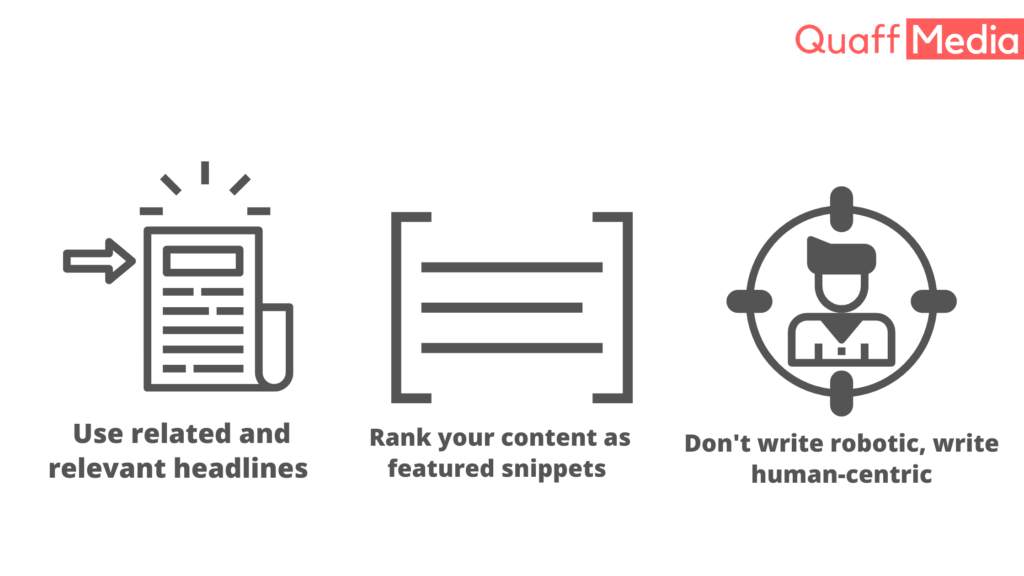6 SEO Strategies that Will Skyrocket Your Website Traffic
It takes hours to research, write, and publish a blog. If your website is not gaining traffic as per your expectations, it is a disappointment.
Good News? There are many ways of dealing with low traffic summed up into an acronym – SEO or Search Engine Optimization. Whether we are bloggers or marketers, we want our content to rank high on Google. SEO is the process that will help you reach that milestone. So, how to incorporate SEO strategies to skyrocket your website traffic?
Below are the top 6 strategies that will help you gain more traffic on your website
1. Use related and relevant headlines
The headings of your blog help google crawlers assess your blog and how it is relevant to the searcher’s query.
Crawlers are like readers who would skim through your blog’s Headings and subheadings (H1, H2, H3) to take an overview of your blog. So, your subheadings should have the essence of the content that you’re writing.
Your heading should have high-intent keywords that reflect the content under the subheadings of the blog. You should use the right keywords that are following the searches of your target audience. The practice of using the right keywords in your headings will help you rank on SERPs more conveniently.

2. Rank your content as featured snippets
When you search for any query on Google a box appears on the top of the page with a bride and direct answer to your query. Those boxes are known as featured snippets.
To get featured on google snippets, you'll need to write a blog that is answering the query of the searcher thoroughly and summarily. Click To TweetFor example, if the query is “How to write a blog”, your H1 could be “A step by step guide on writing a blog” followed by properly drafted steps or bullet points.
If you want to get your content on a featured snippet for a keyword, you can write a definition on the same keyword of not more than 58 words.
3. Don't write robotic, write human-centric
There are many direct and indirect methods of ranking on Google. But one of the most effective methods of ranking your blog on Google SERPs is writing high-quality blogs. The searcher while punching the keywords in the search box has come there to look for an answer. Google’s primary motive is to provide relevant answers to searchers’ queries. Thus, it ranks only those blogs on the top, that are genuinely providing solutions to the searcher’s problem.
Such relevant blogs include end-to-end answers, scannable sections, organized & relevant subheadings, and high-quality visual content.
Try standing in a reader’s shoes while writing any blog. Understand what the reader is looking for in your content when she is searching for anything in the search box. Also, choose the topics that resonate with the queries and pain points of your target audience.
4. Include keywords in your meta description
If you’re not adding meta descriptions to your post, you’re not giving your post the required exposure potential.
Meta descriptions are another space Google crawls to see search rankings. Meta descriptions are the one- to three-sentence descriptions you’ll see beneath the title of a result.
Use meta descriptions, to sum up, what your post is regarding, and keep in mind to:
- Keep it short.
- Use one to 2 keywords.
- Make it compelling. After all, there’ll be alternative posts just like yours, your description ought to stand out on top of the remainder.
Most content management systems (CMS) have meta description boxes, thus you probably will not need to look so much to use the operation.

5. Add elevation text to pictures
With any image, you raise your post – featured or body pictures – to feature elevation text. The elevation text describes what is happening within the icon that helps Google perceive why the icon is in your post.
6. Start with keyword analysis
Google processes over 70k search query a second.
To chop through SERP litter and stand out from your competitors, focus on the particular keywords and phrases your potential customers are checking out.
Start with a keyword analysis tool. Google Keyword Planner provides you with details on what users are checking out and how well-liked those queries are.
Google Trends also can provide you with a sympathize with what keywords are well-liked at any given time.
Use competitive intelligence tools to examine what keywords their domains presently rank for. If these keywords are relevant to your business, think about employing them too.
Conduct keyword analysis sporadically to confirm specialization in the proper keywords for your audience and not miss out on ranking opportunities.

